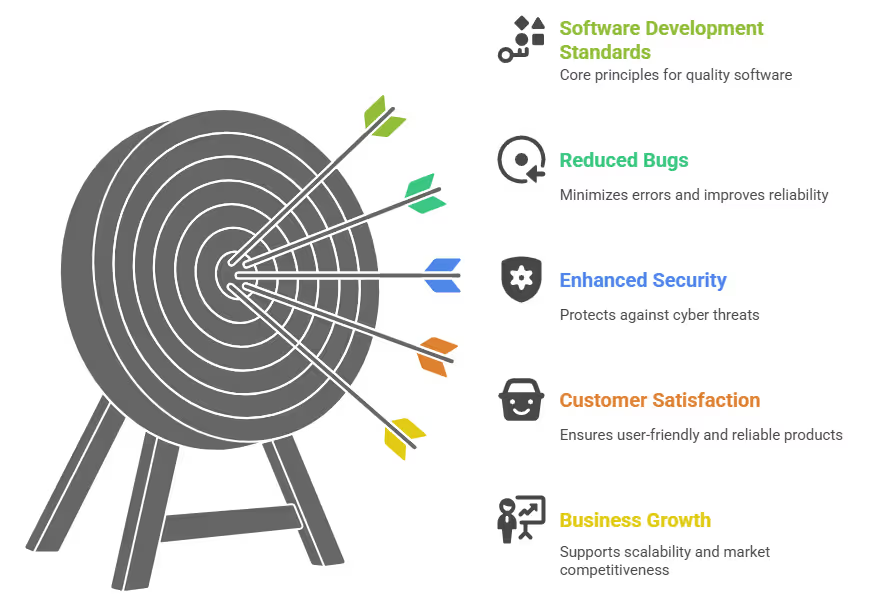Software Development Standards for USA Teams | Guide & Compliance

In today’s highly regulated and competitive digital landscape, software development standards play a critical role in shaping the success of enterprise applications. From ensuring compliance with US regulations to maintaining coding consistency, security, and quality, these standards are more than documentation, they are the foundation of scalable, reliable, and future-ready software. This guide explores the most important standards, frameworks, and best practices every US business should know.
Software development standards are formalized guidelines, best practices, and compliance frameworks that ensure consistent, high-quality, and secure software delivery. For US enterprises, they include ISO/IEC, IEEE, and industry-specific standards that help teams align development, testing, and documentation processes to meet regulatory, security, and performance requirements.
Table of Contents
- Why Software Development Standards and Guidelines Matter
- Key Software Development Standards to Understand
- How to Apply Software Development Guidelines
- Overcoming Common Challenges
- Measuring the Impact of Standards
- The Role of Leadership
- Your Next Steps
Why Software Development Standards and Guidelines Matter
As a CEO, I’ve seen how the right systems can make a business thrive, or fail if they’re not done right. Software development standards and guidelines are the foundation for creating software that’s reliable, user-friendly, and built to last. For CEOs, CTOs, and decision-makers in the USA, understanding these standards is critical to staying competitive in today’s fast-paced tech world.
This post explains why software development standards matter, how they help your business grow, and practical steps to put them into action.
Software development standards and guidelines help your team avoid mistakes, save time, and deliver products that keep customers happy.

For example, following software testing standards can reduce bugs by up to 30%, according to a report by the National Institute of Standards and Technology.
Standards like ISO software development standards ensure your software meets global quality benchmarks, making it easier to scale and compete in industries like finance, healthcare, or e-commerce.
The Cost of Skipping Standards
Ignoring software development process standards can hurt your bottom line. A 2023 report from the Consortium for Information & Software Quality (CISQ) found that poor software quality costs U.S. businesses $2.41 trillion annually.
These costs come from:
- Technical Debt: Messy code that’s hard to fix or update, slowing down future projects.
- Security Risks: Weak software coding standards can leave your software open to cyberattacks, which cost companies an average of $4.35 million per breach, according to IBM’s 2023 Cost of a Data Breach Report.
- Customer Loss: Buggy software frustrates users, leading to churn and lost revenue.
As a CEO, I’ve seen how skipping software quality standards can lead to missed deadlines and unhappy clients.
For example, One project we rushed without proper software design standards resulted in a 20% increase in post-launch fixes. By adopting clear standards, you can avoid these pitfalls and build software that supports your business goals.
Key Software Development Standards to Understand
To make smart decisions, executives need to know the key software development standards.
Here’s a closer look at the most important ones.
ISO Software Development Standards
ISO software development standards, such as ISO/IEC 12207, provide a roadmap for the entire software development process, from planning to maintenance.
With 600 monthly searches, it’s clear businesses value these globally recognized standards. ISO 12207, detailed on the ISO website, covers:
- Process Clarity: Defines roles and tasks for each stage, reducing confusion.
- Risk Management: Identifies and addresses risks early to avoid costly issues.
- Quality Assurance: Ensures software meets customer and regulatory requirements.
For example, In regulated industries like healthcare, ISO standards help ensure compliance with laws like HIPAA. When my company adopted ISO 12207, we reduced project delays by 15% by streamlining our workflows. These standards also make your software more appealing to clients who prioritize compliance, giving you a competitive edge in the USA market.
Software Testing Standards
Testing is your safety net for delivering reliable software. Software testing standards, like those from the International Software Testing Qualifications Board (ISTQB), ensure your product is functional, secure, and user-friendly. With 700 monthly searches, businesses are eager to learn about these standards.
ISTQB outlines key testing types:
- Unit Testing: Checks individual pieces of code to catch errors early.
- Integration Testing: Ensures different parts of the software work together smoothly.
- User Acceptance Testing: Confirms the software meets user expectations.
When we implemented ISTQB-aligned testing, we cut post-launch support tickets by 25%. For example, rigorous integration testing caught a critical bug in a payment system before launch, saving us from potential customer complaints.
The ISTQB syllabus provides detailed guidance to help your team adopt these practices.
Software Quality Standards
Software quality standards, like ISO/IEC 25010, focus on making software reliable, easy to use, and maintainable. With 500 monthly searches, quality is a top priority for businesses.
ISO/IEC 25010, outlined on the ISO website, defines key quality traits:
Following these standards ensures your software delivers value. For instance, focusing on usability helped us improve our app’s Net Promoter Score by 15%, as customers found it easier to use.
Adopting software quality standards also reduces technical debt, making future updates faster and cheaper.
How to Apply Software Development Guidelines
Here’s how to put software development standards and guidelines into practice in your organization.
Set Clear Software Coding Standards
Software coding standards (650 monthly searches) are rules for writing clean, consistent code. They make code easier to read and maintain, saving time in the long run.
Google’s C++ Style Guide is a great example, offering rules like:
- Clear Naming: Use descriptive names like
calculateTotalRevenueinstead of vague ones likecalcRev. - Code Reviews: Have developers check each other’s code to catch mistakes early.
- Automated Tools: Use linters like
ESLintfor JavaScript orPylintfor Python to enforce rules automatically.
When we set coding standards, our code review time dropped by 20%, letting us ship features faster. For example, enforcing consistent naming conventions made it easier for new developers to understand our codebase, reducing onboarding time.
You can start by adopting a style guide tailored to your programming languages, such as Airbnb’s JavaScript Style Guide for JavaScript projects.
Document with Software Documentation Standards
Software documentation standards (350 monthly searches) ensure your team can understand and maintain your code over time.
The IEEE Standard for Software Documentation provides templates for:
- Requirements Documents: Define what the software must do, aligning with business goals.
- Architecture Documents: Explain the system’s structure for future developers.
- User Guides: Help customers use your software effectively.
Good documentation saved us 30% on onboarding time for new developers. For example, when we documented our API clearly, our integration partners reported a 40% reduction in setup time.
To get started, use tools like Sphinx for Python or Swagger for APIs to create professional documentation. Regularly update your docs to reflect changes in your software.
Use Software Design Standards
Software design standards (300 monthly searches) help create systems that scale with your business. The TOGAF framework, developed by The Open Group, guides architects in designing flexible, efficient systems.
Key principles include:
- Modularity: Break systems into smaller, reusable parts.
- Scalability: Design for high user loads, like during Black Friday sales.
- Interoperability: Ensure your software works with other systems.
When we adopted a microservices architecture based on TOGAF, our downtime during peak usage dropped by 15%.
For example, splitting our monolithic app into microservices let us update features without disrupting the entire system.
Start by assessing your current architecture and consulting resources like The Open Group’s TOGAF guide to plan improvements.
Build a Culture of Best Practices
Software development best practices (900 monthly searches) are about creating a team that values quality.
To foster this culture:
- Collaborate: Use tools like Jira or Trello for transparent project tracking.
- Train Regularly: Offer workshops on ISO software development standards or software testing standards.
- Review and Improve: Hold quarterly reviews to update standards based on team feedback.
When we embraced best practices, our team’s productivity and morale improved, cutting delivery times by 10%. For example, regular training on software quality standards helped our developers catch errors earlier, reducing rework.
Encourage your team to share ideas and learn from industry leaders through platforms like GitHub.
Overcoming Common Challenges
Implementing software development process standards (400 monthly searches) can be challenging.
Here’s how to tackle common issues.
Handling Resistance to Change
Developers may resist new standards, thinking they’ll slow down work.
To address this:
- Explain Benefits: Show how standards reduce bugs and save time. For example, we shared data showing a 20% drop in defects after adopting software coding standards.
- Start Small: Test standards on one project, like a new feature, before rolling them out company-wide.
- Involve the Team: Let developers help shape standards to increase buy-in.
When we involved our team in defining standards, adoption rates improved by 30%, and resistance dropped significantly.
Balancing Speed and Quality
Deadlines can pressure teams to skip quality.
To balance:
- Automate Testing: Use CI/CD tools like Jenkins to run tests automatically, catching issues early.
- Prioritize Key Features: Apply software testing standards rigorously to critical areas like payment systems.
- Plan Realistically: Build time for quality checks into project timelines.
For example, automating our testing pipeline saved 15 hours per week, letting us meet deadlines without sacrificing quality.
Keeping Up with New Standards
Standards evolve, and staying current is tough.
To keep up:
- Follow Updates: Subscribe to newsletters from IEEE or ISO.
- Hire Experts: Bring in consultants to audit your processes every 1-2 years.
- Use Communities: Platforms like Stack Overflow share insights on emerging software development best practices.
We set up a monthly “standards review” meeting, which helped us adopt new software quality standards faster, keeping us competitive.
Measuring the Impact of Standards
To show the value of software development standards and guidelines, track these metrics:
For example, after implementing software testing standards, we saw a 25% drop in bug reports, saving $50,000 annually in support costs.
Use tools like Sentry for bug tracking and Jira for delivery metrics to measure success.
The Role of Leadership
As a CEO, your job is to champion quality. CTOs and decision-makers turn that vision into reality. Here’s how:
- Set the Tone: Publicly support software development standards and guidelines in meetings and communications.
- Invest in Resources: Fund tools like GitLab and training on ISO software development standards.
- Track Progress: Review metrics quarterly to ensure standards deliver results.
When we prioritized software quality standards, our customer retention rose by 18%, proving quality drives business success. Leadership’s commitment made all the difference.
Your Next Steps
Software development standards and guidelines are your key to building great software. By adopting ISO software development standards, enforcing software coding standards, and embracing software development best practices, you create products that are reliable, scalable, and customer-focused.
Take these steps today:
- Audit Your Processes: Check how your team uses software testing standards and software documentation standards.
- Train Your Team: Invest in workshops on ISO or ISTQB standards.
- Prioritize Quality: Make quality a core part of your culture.
Ready to get started? Explore resources like the ISO website or ISTQB’s testing guidelines.
Let’s build software that sets the standard!

